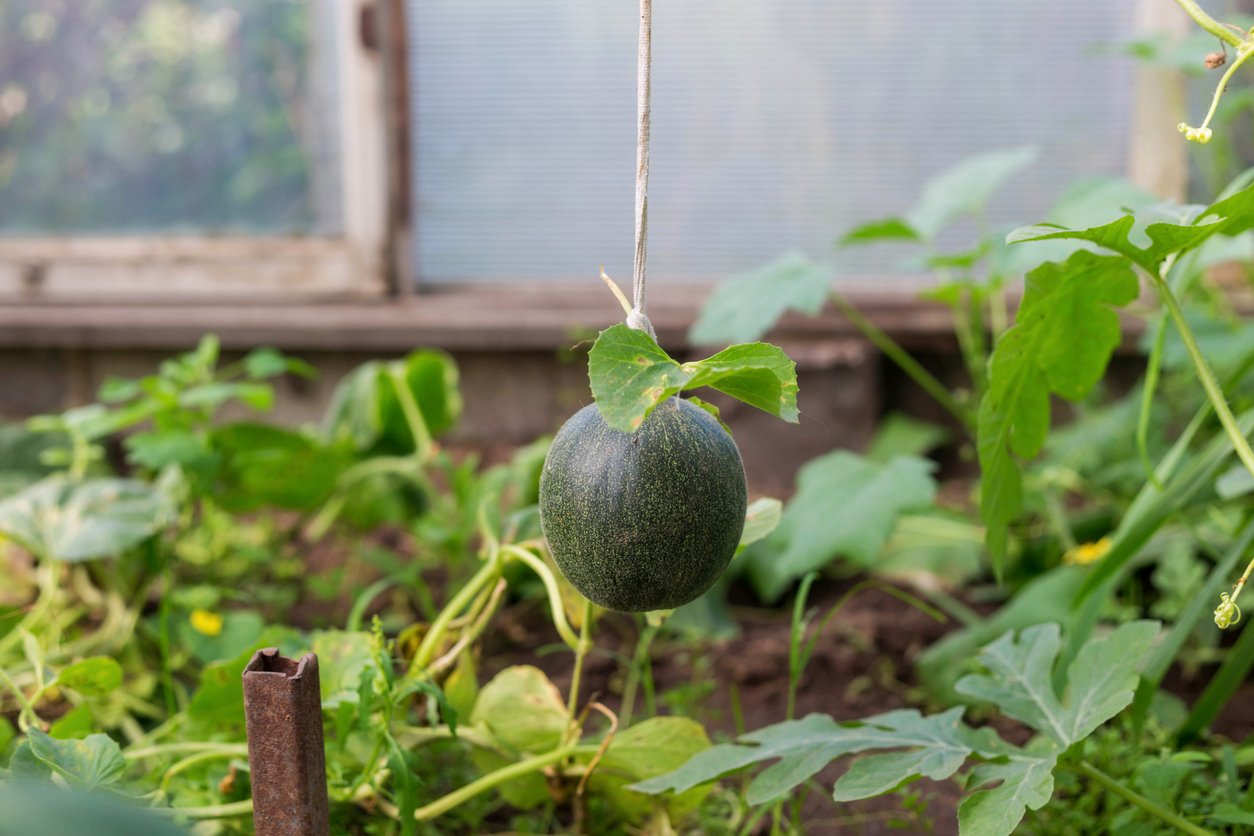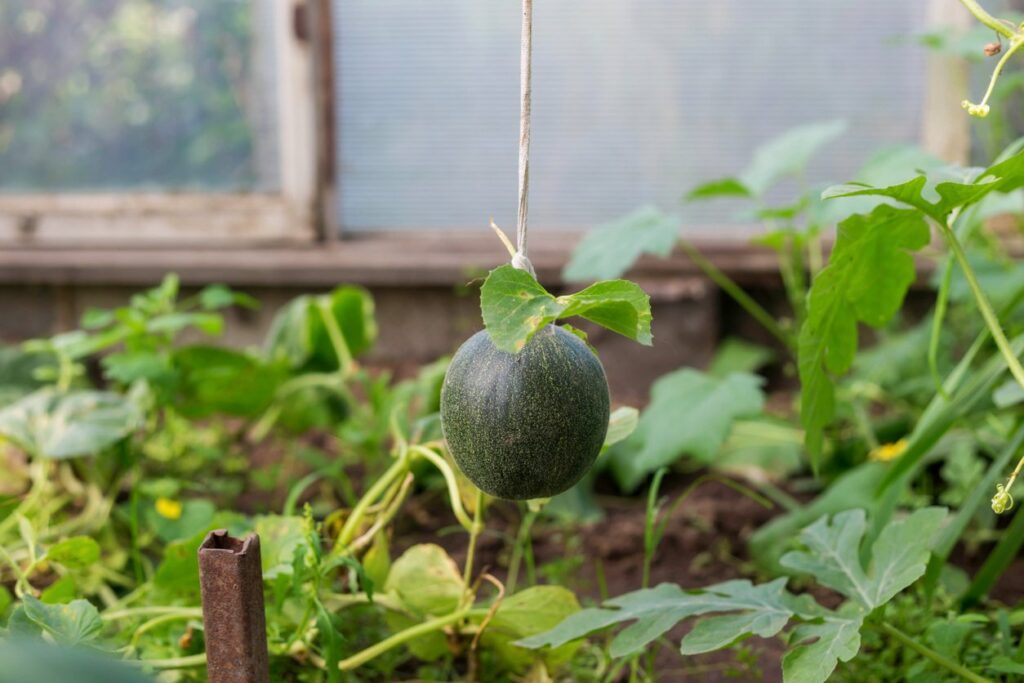Watermelons In Containers – Grow And Harvest Watermelons Vertically
Watermelons are not even fruits, but they make for a really mouth-watering summer snack. Sweet, colorful, and rich in vitamins and minerals. I can’t think of a more appetizing dessert than watermelons to grow out of your garden. But what if you don’t have a garden? Or you only have a small garden that cannot accommodate the sprawling watermelon vines. Then growing watermelons in containers is the right solution for you.
Granted not all watermelons can grow vertically. What with the size and weight of the fruits. So we’ll focus here on the varieties you can grow in a container. We’ll also take a look at the kind of training and support you need to provide to keep the vines growing vertically.
All about Watermelons
As part of the cucurbit family, watermelons (Citrullus lanatus) are actually vegetables. They have more in common with pumpkins and cucumbers than hardcore fruits such as mangos and grapes. Native of Africa, watermelons need hot weather to grow and ripen. The first cultivated watermelon can be traced back to Ancient Egypt about 5,000 years ago.
Back then a watermelon was more seeds, rind, and white veins than sweet and juicy flesh. Over the years, agriculturalists worked on new hybrids with an increased mass of flesh. Seedless watermelons are commonplace and you can get them at the store or even grow them in your backyard.
A watermelon, just like your body, is mostly water. With about 92 percent of the watermelon’s mass as water, it’s a good source of hydration on a long hike or a picnic. The “fruit” is rich in the antioxidant lycopene, protein, zinc, magnesium, and vitamin C.
Not all watermelons are red. Different varieties have different colors including yellow, white, green, and orange. The Brix scale is the official standard to measure the sweetness of the watermelon. Most varieties average about 9 or 10 on that scale. A very sweet watermelon could hit the 12 mark on the Brix scale, but that’s rare.
Container Watermelon Varieties
Experts have recorded over 300 types of watermelon. Out of those, only 50 varieties make it to your grocery store. But since we’re talking about growing watermelons in containers, then you’ll need to find specific varieties for that purpose. The vine has to be compact and the fruits small in size. Here are the best container watermelon varieties to grow.
- Sugar Baby: A seeded variety with a round fruit that averages between 7 to 10 pounds. The flesh of the watermelon is firm and fine-grained. It is usually red and very sweet. The outer skin is dark green. The vine is small in size making it ideal for containers.
- Crimson Sweet: The fruit is usually oblong and weighs up to 25 pounds. The dense flesh is sweet with high concentrations of sugar. It is high in lycopene as well which explains its popularity. The outer skin is light green with dark green stripes while on the inside, it’s usually red. It has small black seeds.
- Yellow Doll: Another seeded variety with small fruits that weigh between 5 and 8 pounds. You won’t have much trouble growing this variety vertically in a container. When ripe, the flesh turns yellow and is quite sweet and juicy. The skin is usually light green with dark green stripes.
- Jubilee: The elongated fruit weighs about 25 pounds so it can be a little tricky to grow it vertically. You’ll need to keep the fruits close to the ground since no trellis or fence can support their weight. The seeded flesh has a fine texture and is sweet. The skin is usually light green with dark green patterns.
- Moon and Stars: A popular variety with unique dark green skin and yellow spots all over it. The flesh is pale red but very sweet. The round fruit can reach about 40 pounds so you need some experience with vertical growing to successfully grow this one. This is a seeded variety as well.
Of all these varieties, perhaps the best one to start with is the Yellow Doll. It is a compact vine with small fruits that will reward you for your hard work with tasty and sweet watermelons.
How to Grow Watermelons in Containers
Since you’re going to grow a vine that carries fruits that weigh about 8 pounds, that means you need to pick suitable containers. You’ll also need a support system such as a trellis or a fence. Here’s how to grow watermelons in containers in simple steps.
- Start the seeds indoors about 4 weeks before the last frost.
- Fill a small pot with a soilless mix and plant a couple of seeds in it.
- Cover the seeds with soil and water lightly to get the mix moist but not soaked.
- Keep the pots in a warm place away from direct sunlight.
- The seeds will often germinate within a week to 10 days depending on the room temperature.
- Thin out the seedlings leaving on the strongest plant in each pot.
- Move the pots to a sunny spot to harden them and prepare them for outdoor conditions.
- Select a large container such as a 5-gallon bucket to grow your watermelon vine. You could also use a washtub. Make sure that it has plenty of drainage holes.
- Before you fill the container with the soil, choose a sunny spot away from strong winds, and place it there. Once you fill the container, it will be hard to move around.
- As you might expect, the vine with its growing fruits is top-heavy so you need to weigh down the container. Drop a few rocks at the bottom to keep it even-keeled.
- Erect a sturdy trellis near the container and attach a wire fencing around the container itself to help the vines climb.
- Now fill the container with a mix of sand and organic compost.
- Dig a large hole in the potting mix to accommodate the root ball of the plant along with the soilless mix.
- Ease the plant out of the pot making sure not to disturb the roots or expose them to the air then place it in the hole. Fill back with soil and pack it to push out air pockets.
- Water the container immediately and keep the soil moist.
Watermelon Care
When the watermelon vine starts to grow and send out aggressive tendrils, that’s when you need to train it and guide it up the trellis you erected near the container. It takes constant care and vigilance to get the flowers pollinated and protect the fruits against pests and predators.
Soil
The soil has to be well-drained and sandy for the roots of the watermelon plant to grow freely. Loamy and neutral soil is the best. So make sure the pH levels are between 6 and 6.8 at most. To improve drainage, try to fill the bottom of the container with rocks and gravel. Mix the soil with rabbit and horse manure to improve its texture and promote aeration.
Water
Since the ripe watermelon is about 92 percent water, that means the vines crave a lot of water. But you’ll need to water it moderately. Always strive to keep the soil moist and never irrigate the plant until the top couple of inches of the soil are dry. Usually, you’d water it in the early morning. If by the afternoon, the soil is completely dry, you might have to water it again. If the soil is still moist, then you’ll need to wait for the next day to water it.
Fertilizer
Besides the organic compost and horse manure you mix with the soil to give the plant a good start, you also need a liquid fertilizer. Apply a balanced liquid fertilizer until the plant starts to flower. Then switch to a customer liquid fertilizer that is low on nitrogen.
Pruning
Believe it or not, you’ll need to prune the watermelon plant to keep it growing strong. Regularly remove any side branches and damaged vines. This helps the plant focus on flowering and producing fruits rather than wasting resources on foliage. Keep the main branch growing and remove any infected leaves.
Pollinating
Yes, you have to take care of that as well. In your pursuit to get a juicy and sweet watermelon fruit, you’ll have to act like a bee. Each vine produces both male and female flowers. While bees and butterflies could do that task, you still have to hand pollinate the flowers just to be sure. It will take about 40 days after pollination for the fruits to develop.
Pests and Diseases
Besides aphids which feed on the leaves and juicy tendrils, cucumber beetles attack the developing fruits and drill gaping holes in them. Treat the aphids with neem oil or soak them with a swap drenched in alcohol. As for the beetles, just pick them up and drown them in a bucket full of water and some detergent.
Root rot is a common issue due to waterlogged soil. Also, powdery mildew is a common fungal infection in humid conditions. Ensure the plants have air circulation and don’t sprinkle the leaves or vines with water.
Harvesting
Most watermelon varieties will take between 80 to 90 days from the day you plant them to produce ripe fruits. You might get several harvests in one season depending on the weather conditions. But the tricky part is how to determine that your fruit is ripe and ready for the picking.
Experts recommend two ways. The first is to tap on the watermelon with your fingers. If you heard a dead hollow sound, that means it’s ripe. The other sign is to check the tendril the fruit is hanging from. If it’s wilted and half shrunk, that means the fruit is ripe.

